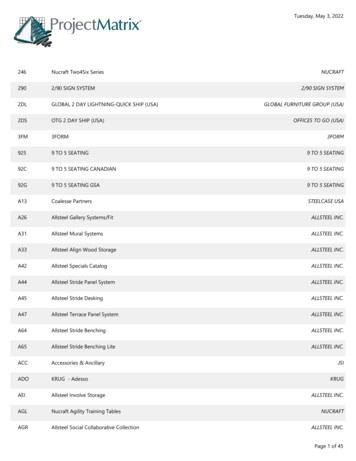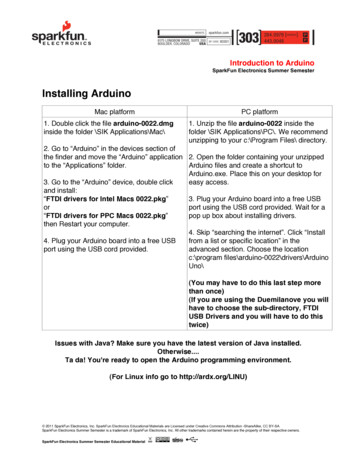
Transcription
Electronics Essentialsfor 2.017Massachusetts Institute of Technology, Subject 2.017
Reviewing Basics Kirchoff’s Voltage rule: voltages V at a node are thesame. Kirchoff’s Current rule: sum of currents i flowing into andout of a node is zero. Analogy: Voltage is like fluid pressure, current is likefluid volumetric flow rate. The wire is like a pipe. Resistor R: V IR,Ohms, – Dissipation: Resistive Power P I2R V2/R– Analogy: viscous losses in pipe flow Capacitor C: i C dV/dtfarads, f– Analogy: a hydraulic accumulator Inductor H: V L di/dt– Analogy: inertia of water in a pipeMassachusetts Institute of Technology, Subject 2.017henries, h
The Op-AmpTwo inputs (called inverting and non-inverting); oneoutput.The output voltage is a HUGE gain multiplied by thedifference between the inputs.V (supply)VinvVoutVnon-invV- (supply)Horiwitz’s & Hill’s golden rules:a. The op-amp enforces (in proper use)Vinv Vnon-invb. No current flows into the device at either inputMassachusetts Institute of Technology, Subject 2.017
Example Op-Amp: Adding a Voltage BiasR2V R1V(V-Vinv)/R1 (Vinv-Vout)/R2 andVinv Vnon-inv VoutVinvVR2 Vinv(R1 R2) – VoutR1 Vout Vnon-inv (R1 R2)/R1 – VR2/R1Vnon-invVVoltage bias useful for bringingsignal levels into the range ofsensors.The op-amp is discussed in detailby Horowitz and Hill, coveringintegrators, filters, etc.Massachusetts Institute of Technology, Subject 2.017Letting R1 R2, thenVout 2Vnon-inv – VThe circuit inverts the input V andadds on 2Vnon-invIF Vnon inv is ground, thenVout is just –V. This is just aninverting amplifier.
Serial Communications How to transmit digital information fast and reliably overa few wires? Examples: RS-232, RS-485, etc. refer to pins & wires A minimal case of RS-232 (DB25 connector is full case):– Asynchronous operation; both sides agree on BAUD rate– Three wires: send (TX), receive (RX), ground– No error checking! No flow control!EXAMPLE using CMOS components:2 4 8 16 128 158 ‘ ’ (underline)5V011’s2’s(LSB)Massachusetts Institute of Technology, Subject 2.01711104’s8’s16’s32’s0164’s 128’s(MSB)Stop bitStart bitnormally highSuccessive bits read at midpoints,based on baud rate and on start bitleading edgeGND
EXAMPLE: A GPS String Garmin GPS25 series – Smart embedded device! Similar to TT8’s interface with you – I/O strings arepassed through a serial port Reconfigurable through special commands Output at 1Hz String maintains exactly the same syntax: e.g., 0,ddmmyy,000.0,E,N,*XX CR LF 73 chars appear as one line: 0,ddmmyy,000.0,E,N,*XXMassachusetts Institute of Technology, Subject 2.017
ASCII: American Standard Code for Information InterchangeSerial devices communicate using characters encoded into bits. This includesupper- and lowercase letters, carriage returns and linefeeds, punctuation, etc.Characters are not numbers! E.g.,char c ‘7’ ;char d[2] ‘92’ ;int n ;The numerical value of c is [00110111] (binary) or 55 (decimal).But because the ASCII characters �6’,’7’,’8’, and ’9’ occur inorder, making simple conversions is easy:n c – ‘0’ ;assigns to n the actual number 7. The ASCII character that goes with 7 isknown as BEL – on many machines this will ring a bell if it is sent to the screenas a character! – printf(“%c”,n) ;How to turn d[2] into a number?n 10*( d[0] - ’0’ ) ( d[1] - ’0’ ) ;Massachusetts Institute of Technology, Subject 2.017
Pulse Width Modulation A Regular WaveformVoltsVpeakPWM periodPulsewidth PWM frequency (Hz) 1 / PWM period Duty cycle Pulsewidth / PWM period PWM frequencies typically range from 100Hz into MHz Duty cycles can be used from 0 – 100%, although some systemsuse much smaller ranges, e.g. 5-10% for hobby remote servos. The waveform has two pieces of information: Period andPulsewidth, although they are usually not changed simultaneously.Massachusetts Institute of Technology, Subject 2.017
Some PWM Uses The Allure: very fast, cheap switches and clocks to approximatecontinuous processes. Also, two-state signal resists noise corruption. Sensors: PWM period is naturally related to rotation or update rate:Hall effect, anemometers, incremental encoders, tachometers, etc. Communication: PWM duty cycle is continuously variable like an D/Aand an A/D. Actuation: At very high frequencies, physical systems filter out all butthe mean; i.e.,Veffective duty cycle * VpeakHigh frequencyswitching is thedominant modefor poweringlarge motors!Massachusetts Institute of Technology, Subject 2.017
Field Effect Transistor (FET) Like a “valve”, that is very easy to open or close. WhenFET is open, resistance is low (milli-Ohms); when FET isclosed, resistance is high (mega-Ohms or higher)drain Typically three connections:– Gate: the signal; low current– Source: power in– Drain: power outLoadgatesourceSupply N- and P-type junctions are common, and involve thepolarity of the device. (N is shown) Extremely sensitive to static discharge! Handle withcare. MOSFET: modern FET’s capable of handling higherpower levels.Massachusetts Institute of Technology, Subject 2.017
Bipolar Control with a MOSFET H-BridgedrainLoadgategateN-channelsourceSupply MOSFET turns on when Vgate VsourceVssP1sgdsBgdgCDP2dloaddN1AgN2sMassachusetts Institute of Technology, Subject 2.017drain LoadP-channelsource SupplyMOSFET turns on when Vgate VsourceTo make flow UL to LR,set A GND and D VsTo make flow UR to LL,Set B GND and C VsConnect A and B to Vs with pull-up resistors;Connect C and D to GND with pull-down resistors;Control all four gates explicitly
The Basic DC Brush MotorTorque (coils)(flux density)(current i),or, in a given motor, kt * iVector relations:force current x fluxfield velocity x fluxwhere kt is the torque constantiBut the motion of the coils also induces avoltage in the coil, the back-EMF:eb kt * YES, that’s the same kt And the windings have a resistance R:eR R * iSumming voltages around the loop,Vsupply eb eRMassachusetts Institute of Technology, Subject 2.017SN
Properties of the DC Brush Motor No-load speed: 0 i 0 V / ktZero-speed torque (BURNS UP MOTOR IF SUSTAINED): 0 eb 0 i V / R kt V / RPower output:Pout i eb Pout i ( V – Ri )Efficiency: Pout / Pin / i V 1-iR/V Point of maximum power: kt V / 2 R V / ktPoutd /d - R / kt2Massachusetts Institute of Technology, Subject 2.017 ktV/R
Incremental Encoders for Control What is the position of the motor?Take advantage of cheap, fast counters make a largenumber of pulses per revolution, and count them!Advantages of the incremental encoder:– High resilience to noise because it is a digital signal– Counting chip can keep track of multiple motor turns– Easy to make – phototransistor, light source, slotted disk Two pulse trains required to discern direction: quadratureZABMassachusetts Institute of Technology, Subject 2.0175V5Vslots
Switched coils atfixed positions onthe stator attractpermanentmagnets at fixedpositions on therotor.SNSRotor withpermanentmagnetsSmooth variationof switching leadsto half-steppingand microsteppingEncoder stillrecommended!Massachusetts Institute of Technology, Subject 2.017NDC VoltageStepperMotorsSStatorOFFDC VoltageON
MIT OpenCourseWarehttp://ocw.mit.edu2.017J Design of Electromechanical Robotic SystemsFall 2009For information about citing these materials or our Terms of Use, visit: http://ocw.mit.edu/terms.
Electronics Essentials for 2.017. Massachusetts Institute of Technology, Subject 2.017 Reviewing Basics Kirchoff’s Voltage rule: voltages V at a node are the same. Kirchoff’s Current rule: sum of currents i flowing into and out of a node is zero. Analogy: Voltage is like fluid pressure, current is like fluid volumetric flow rate. The wire is like a pipe. Resistor R: V IR .










